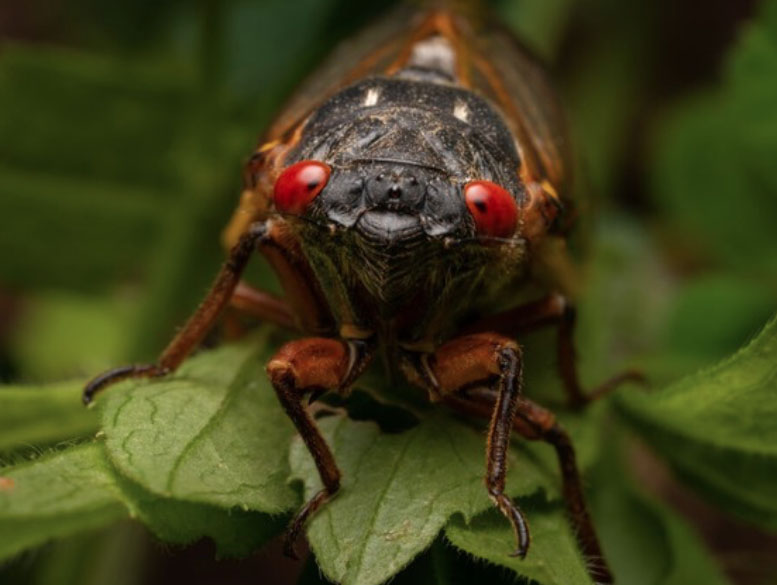Over the next few months more than a trillion cicadas of broods XIX and XIII are co-emerging for the first time since 1803 across 17 U.S. states. While more than 200 species of cicadas live in North America, the co-emergence of two specific broods happens only once every 221 years, and this year is one of those years. The next time will be 2245.
The two multi-species broods of cicadas, one a 13-year life cycle (Brood XIII) and the other on a 17-year cycle (Brood XIX) spend 99 percent of their lives underground as nymphs before emerging all at once to moult, mate, lay eggs then die over a period of a few months. The nymphs leave their underground home when the soil warms to about 17.7C degrees. Once emerged, the nymphs find a hard surface to cling to—like a tree trunk or telephone pole—then moult into winged adults.
.
Where The Dual-Emergence Is Happening & Will That Change with Climate Change?
This dual cicada brood emergence will be mainly experienced in parts of Illinois, Iowa and Wisconsin, as well as parts of Kentucky, Missouri, Arkansas, Tennessee, Mississippi, Alabama, Georgia, South Carolina, North Carolina, Virginia, and Montana.

Environmental scientists predict that with climate change these broods will eventually migrate north, possibly into Canada. Scientists are also observing climate change-induced changes in brood emergence patterns. In an Washington Post article, scientist Chris Simon (professor in the University of Connecticut’s Ecology and evolutionary Biology Department) noted that in 2017 a significant number of chorusing Brood X cicadas had emerged from their 17-year adolescence four years early.
“In the past 10,000 years, periodical cicadas moved from what is now the southeastern United States to occupy an area stretching as far north as Nebraska, southern Michigan and Massachusetts. They returned north as the advancing edge of the deciduous trees recolonized their interglacial range and coniferous forests retreated to what is now Canada and northern New England.”
Chris Simon, Washington Post
Clearing land for agriculture in the 1800s and early 1900 of the eastern United States drastically reduced cicada populations, resulting in the extinction of Brood XI in New England. According to Simon, urbanization and climate change are the most powerful forces facing cicadas. Climate change is already altering tree species composition. But periodical cicadas are generalists, says Simon; they can lay eggs and feed in many types of trees and shrubs. they can thrive in suburbs with forest edges, forming a mosaic of broods. Simon suggests that with climate change, 17-year cicadas may eventually become 13-year cicadas. This has already happened in the upper Mississippi Valley. In the south, 13-year cicadas may switch to a nine-year life cycle.
.
What the Cicadas Do: Fly, Sing, Mate and Lay Eggs
After the cicadas moult into adults, the insects live for four to six weeks into July. They are not the best fliers, not flying much farther than the width of a football field, according to Chris Simon. “Males gather in chorusing trees, and females only move to find mates and lay eggs in the young and vigorously growing trees on forest edges that are likely to be standing in 17 years.”
If you’re in the coverage zone, Floyd Shockley, an entomologist with the Smithsonian National Museum of Natural History in Washington, D.C., says you’ll likely find them near the ground in the early morning. As it warms up during the afternoon, they’ll “start flying around looking for a really great perch to start singing from.”
That “singing” is actually a mating call the males make using special organs called tymbals (ribbed membranes on each side of the base of the abdomen) attached by a tendon to a powerful muscle. “They’re very gentle,” Shockley adds. “They don’t bite. I think they definitely get a bad rap.” In fact, he says, they are an abundant food source for wildlife. Birds, amphibians, mammals, other insects and reptiles will gorge on them.
.
Cicadas in Canada
While the U.S. is home to a range of periodical cicadas, the three species of cicadas found in Canada are annual; they emerge every summer.
The Canadian Cicada (Okanagana Canadensis), active from June to July and peaking in June, occurs across most provinces and territories except the Northwest territories and Nunavut. Say’s Cicada (Okanagana rimosa) also occurs in Canada and is active for the same time period.
If you live in Southern Ontario you will be familiar with the high-pitched drone of the Dog Day Cicada that reminds me of the whine of a small buzz saw. Dog-day Cicadas (Tibicen canicularis) have distinctive green markings and are widespread, often found on or around pine trees. And they are highly vocal.
The common name comes from this species’ habit of peak singing during the time of the year when the star Sirius, of the constellation Canis Major (the big dog), is prominent in the night sky. The typically hot and muggy days of July and August are referred to as the “dog days” of summer.

Nina Munteanu is a Canadian ecologist / limnologist and novelist. She is co-editor of Europa SF and currently teaches writing courses at George Brown College and the University of Toronto. Visit www.ninamunteanu.ca for the latest on her books. Nina’s bilingual “La natura dell’acqua / The Way of Water” was published by Mincione Edizioni in Rome. Her non-fiction book “Water Is…” by Pixl Press (Vancouver) was selected by Margaret Atwood in the New York Times ‘Year in Reading’ and was chosen as the 2017 Summer Read by Water Canada. Her novel “A Diary in the Age of Water” was released by Inanna Publications (Toronto) in June 2020.






